VOLVO XC60 2009 Owner´s Manual
Manufacturer: VOLVO, Model Year: 2009, Model line: XC60, Model: VOLVO XC60 2009Pages: 297, PDF Size: 21.16 MB
Page 161 of 297
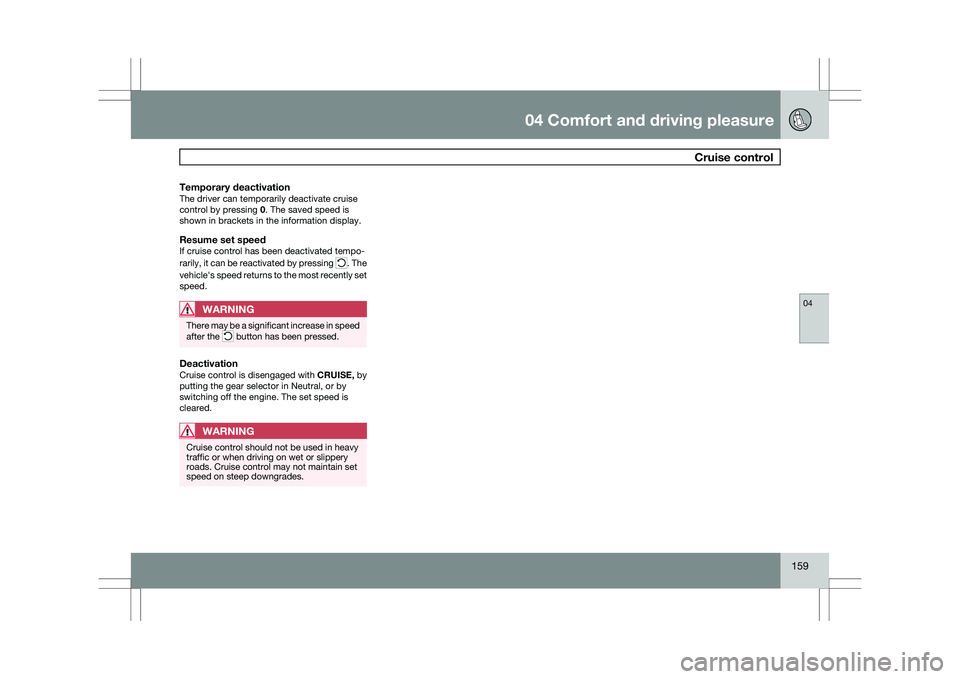
04 Comfort and driving pleasure
Cruise control04
159
Temporary deactivationThe driver can temporarily deactivate cruise
control by pressing
0. The saved speed is
shown in brackets in the information display.
Resume set speedIf cruise control has been deactivated tempo-
rarily, it can be reactivated by pressing . The
vehicle\fs speed returns to the most recently set
speed.
WARNING There may be a significant increase in speed
after the
button has been pressed.
DeactivationCruise control is disengaged with
CRUISE, by
putting the gear selector in Neutral, or by
switching off the engine. The set speed is
cleared.
WARNING Cruise control should not be used in heavy
traffic or when driving on wet or slippery
roads. Cruise control may not maintain set
speed on steep downgrades.
Page 162 of 297
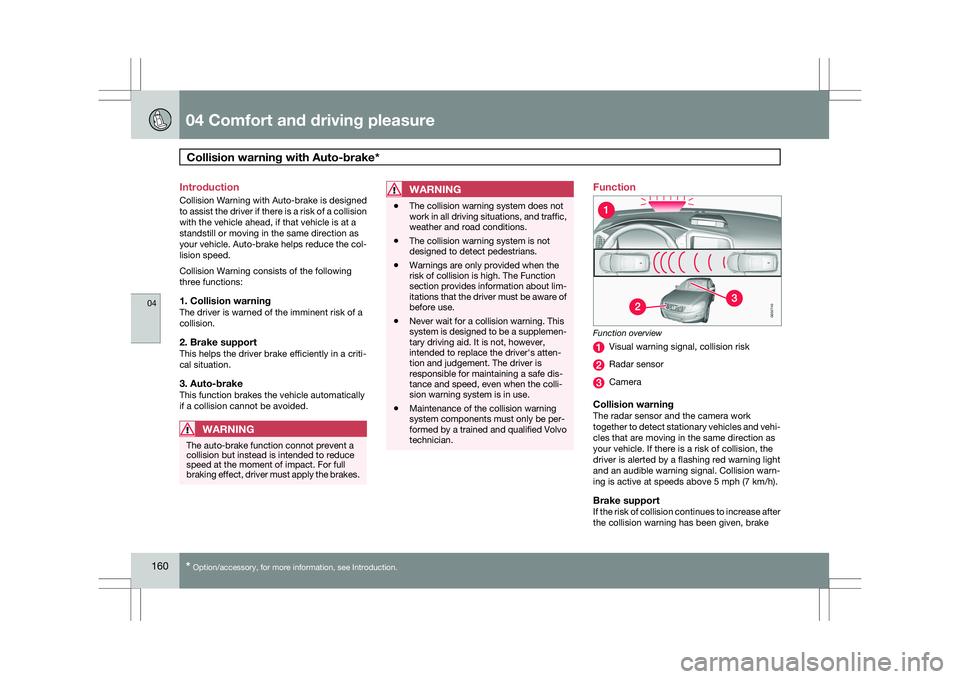
04 Comfort and driving pleasureCollision warning with Auto-brake* 04
160
* Option/accessory, for more information, see Introduction.
Introduction
Collision Warning with Auto-brake is designed
to assist the driver if there is a risk of a collision
with the vehicle ahead, if that vehicle is at a
standstill or moving in the same direction as
your vehicle. Auto-brake helps reduce the col-
lision speed.
Collision Warning consists of the following
three functions:
1. Collision warningThe driver is warned of the imminent risk of a
collision.
2. Brake supportThis helps the driver brake efficiently in a criti-
cal situation.
3. Auto-brakeThis function brakes the vehicle automatically
if a collision cannot be avoided.
WARNING
The auto-brake function connot prevent a
collision but instead is intended to reduce
speed at the moment of impact. For full
braking effect, driver must apply the brakes.
WARNING \b
The collision warning system does not
work in all driving situations, and traffic,
weather and road conditions.
\b The collision warning system is not
designed to detect pedestrians.
\b Warnings are only provided when the
risk of collision is high. The Function
section provides information about lim-
itations that the driver must be aware of
before use.
\b Never wait for a collision warning. This
system is designed to be a supplemen-
tary driving aid. It is not, however,
intended to replace the driver\fs atten-
tion and judgement. The driver is
responsible for maintaining a safe dis-
tance and speed, even when the colli-
sion warning system is in use.
\b Maintenance of the collision warning
system components must only be per-
formed by a trained and qualified Volvo
technician. Function
Function overview
Visual warning signal, collision risk
Radar sensor
Camera
Collision warningThe radar sensor and the camera work
together to detect stationary vehicles and vehi-
cles that are moving in the same direction as
your vehicle. If there is a risk of collision, the
driver is alerted by a flashing red warning light
and an audible warning signal. Collision warn-
ing is active at speeds above 5 mph (7 km/h).
Brake supportIf the risk of collision continues to increase after
the collision warning has been given, brake G032740
Page 163 of 297
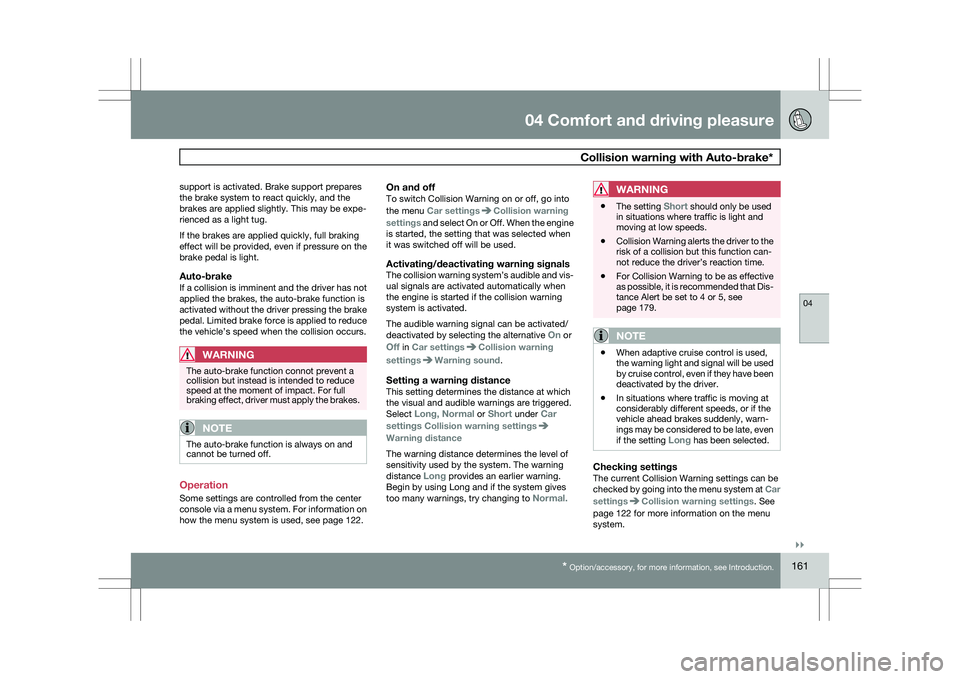
04 Comfort and driving pleasure
Collision warning with Auto-brake*04
}}
* Option/accessory, for more information, see Introduction. 161
support is activated. Brake support prepares
the brake system to react quickly, and the
brakes are applied slightly. This may be expe-
rienced as a light tug.
If the brakes are applied quickly, full braking
effect will be provided, even if pressure on the
brake pedal is light.
Auto-brakeIf a collision is imminent and the driver has not
applied the brakes, the auto-brake function is
activated without the driver pressing the brake
pedal. Limited brake force is applied to reduce
the vehicle’s speed when the collision occurs.
WARNING
The auto-brake function connot prevent a
collision but instead is intended to reduce
speed at the moment of impact. For full
braking effect, driver must apply the brakes.
NOTE
The auto-brake function is always on and
cannot be turned off.
Operation
Some settings are controlled from the center
console via a menu system. For information on
how the menu system is used, see page 122.
On and offTo switch Collision Warning on or off, go into
the menu Car settings Collision warning
settings and select On or Off. When the engine
is started, the setting that was selected when
it was switched off will be used.
Activating/deactivating warning signalsThe collision warning system’s audible and vis-
ual signals are activated automatically when
the engine is started if the collision warning
system is activated.
The audible warning signal can be activated/
deactivated by selecting the alternative On or
Off in Car settings Collision warning
settings Warning sound.
Setting a warning distanceThis setting determines the distance at which
the visual and audible warnings are triggered.
Select Long, Normal or Short under Car
settings Collision warning settings
Warning distance
The warning distance determines the level of
sensitivity used by the system. The warning
distance Long provides an earlier warning.
Begin by using Long and if the system gives
too many warnings, try changing to
Normal.
WARNING \b
The setting
Short should only be used
in situations where traffic is light and
moving at low speeds.
\b Collision Warning alerts the driver to the
risk of a collision but this function can-
not reduce the driver’s reaction time.
\b For Collision Warning to be as effective
as possible, it is recommended that Dis-
tance Alert be set to 4 or 5, see
page 179.
NOTE \b
When adaptive cruise control is used,
the warning light and signal will be used
by cruise control, even if they have been
deactivated by the driver.
\b In situations where traffic is moving at
considerably different speeds, or if the
vehicle ahead brakes suddenly, warn-
ings may be considered to be late, even
if the setting Long has been selected.
Checking settingsThe current Collision Warning settings can be
checked by going into the menu system at
Car
settings Collision warning settings. See
page 122 for more information on the menu
system.
Page 164 of 297

04 Comfort and driving pleasureCollision warning with Auto-brake* 04
162
* Option/accessory, for more information, see Introduction.
LimitationsStrong sunlight, reflections, extreme light con-
trasts, the use of sunglasses, or if the driver is
not looking straight ahead may make the visual
warning signal in the windshield difficult to see.
For this reason, always activate the audible
warning signal in such conditions.
NOTE The visual warning signal may be temporar-
ily disengaged in the event of high passen-
ger compartment temperature due to strong
sunlight, etc. If this occurs, the audible
warning signal will be used, even if it has
been deactivated in the menu system.
Warnings may not appear if the distance to the
vehicle ahead is very small or if steering wheel
and pedal movements are great, for example,
due to a very active driving style.
WARNING \b
In certain situations, the system cannot
provide warnings or warning may be
delayed if traffic conditions or other
external factors make it impossible for
the radar sensor or camera to detect the
vehicle ahead.
\b Warnings may not be provided if the
distance to the vehicle ahead is short,
or if movements of the steering wheel/
brake pedal are great, such as during
active driving.
\b The sensor system has a limited range
for stationary or slow-moving vehicles
and may therefore give delayed or no
warnings if your vehicle’s speed is
above approximately 45 mph
(70 km/h).
\b Warnings for stationary or slow-moving
vehicles may not be provided in dark
conditions. The Collision Warning system uses the same
radar sensors as Adaptive Cruise Control. For
more information on the radar sensor and its
limitations, see page 175
.
If no warning is given, or if a warning is delayed,
Auto-brake will also not be provided or will be
delayed.
NOTE If warnings are given too frequently, the
warning distance can be reduced (see
page 161). This causes the system to pro-
vide later warnings, which decreases the
total number of warnings provided.
The camera’s limitationsThe camera is used by Collision Warning with
Auto-brake, Driver Alert Control (see
page 182), and Lane Departure Warning (see
page 185).
NOTE
\b
To help protect the camera in very hot
conditions, it may be temporarily
switched off for approximately 15
minutes after the engine has been
started.
\b Keep the section of the windshield in
front of the camera clean and free of ice,
snow, or condensation.
Page 165 of 297
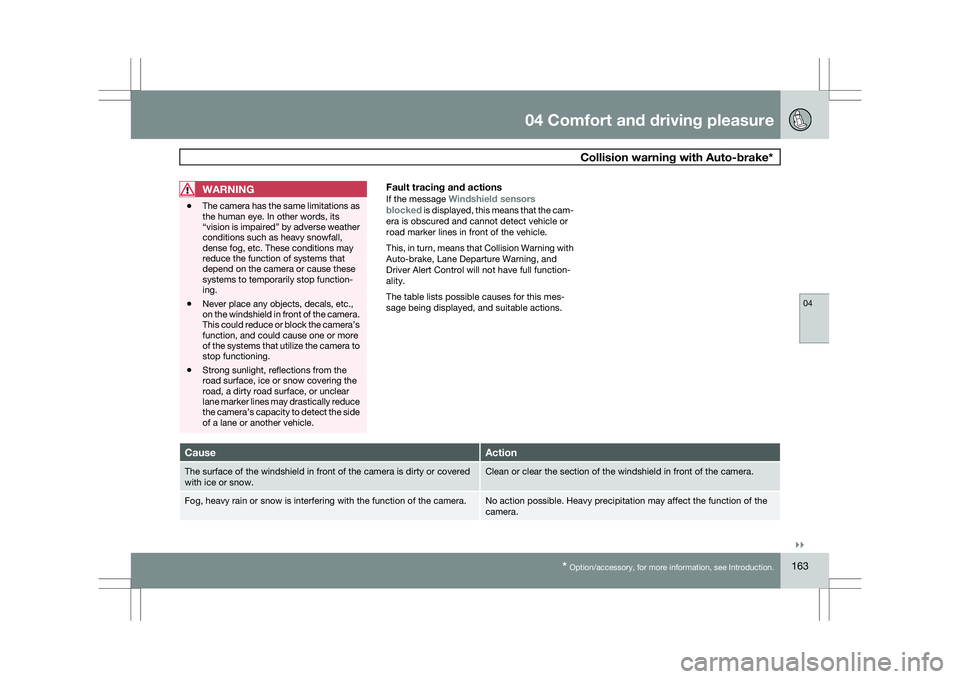
04 Comfort and driving pleasure
Collision warning with Auto-brake*04
}}
* Option/accessory, for more information, see Introduction. 163
WARNING\b
The camera has the same limitations as
the human eye. In other words, its
“vision is impaired” by adverse weather
conditions such as heavy snowfall,
dense fog, etc. These conditions may
reduce the function of systems that
depend on the camera or cause these
systems to temporarily stop function-
ing.
\b Never place any objects, decals, etc.,
on the windshield in front of the camera.
This could reduce or block the camera’s
function, and could cause one or more
of the systems that utilize the camera to
stop functioning.
\b Strong sunlight, reflections from the
road surface, ice or snow covering the
road, a dirty road surface, or unclear
lane marker lines may drastically reduce
the camera’s capacity to detect the side
of a lane or another vehicle.Fault tracing and actions
If the message Windshield sensors
blocked is displayed, this means that the cam-
era is obscured and cannot detect vehicle or
road marker lines in front of the vehicle.
This, in turn, means that Collision Warning with
Auto-brake, Lane Departure Warning, and
Driver Alert Control will not have full function-
ality.
The table lists possible causes for this mes-
sage being displayed, and suitable actions. Cause Action
The surface of the windshield in front of the camera is dirty or covered\
with ice or snow. Clean or clear the section of the windshield in front of the camera.
Fog, heavy rain or snow is interfering with the function of the camera. No action possible. Heavy precipitation may affect the function of the
camera.
Page 166 of 297
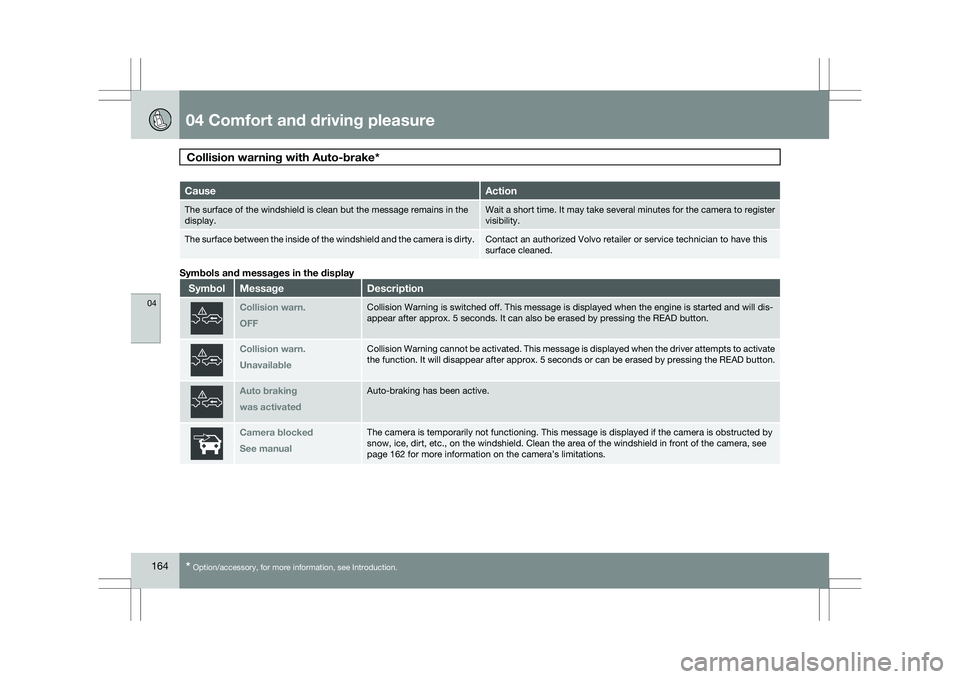
04 Comfort and driving pleasureCollision warning with Auto-brake* 04
164
* Option/accessory, for more information, see Introduction.Cause Action
The surface of the windshield is clean but the message remains in the
display. Wait a short time. It may take several minutes for the camera to registe\
r
visibility.
The surface between the inside of the windshield and the camera is dirty\
. Contact an authorized Volvo retailer or service technician to have this
surface cleaned.
Symbols and messages in the display
Symbol Message Description
Collision warn.
OFF Collision Warning is switched off. This message is displayed when the en\
gine is started and will dis-
appear after approx. 5 seconds. It can also be erased by pressing the RE\
AD button.
Collision warn.
Unavailable Collision Warning cannot be activated. This message is displayed when th\
e driver attempts to activate
the function. It will disappear after approx. 5 seconds or can be erased\
by pressing the READ button.
Auto braking
was activated Auto-braking has been active.
Camera blocked
See manual The camera is temporarily not functioning. This message is displayed if \
the camera is obstructed by
snow, ice, dirt, etc., on the windshield. Clean the area of the windshie\
ld in front of the camera, see
page 162 for more information on the camera’s limitations.
Page 167 of 297
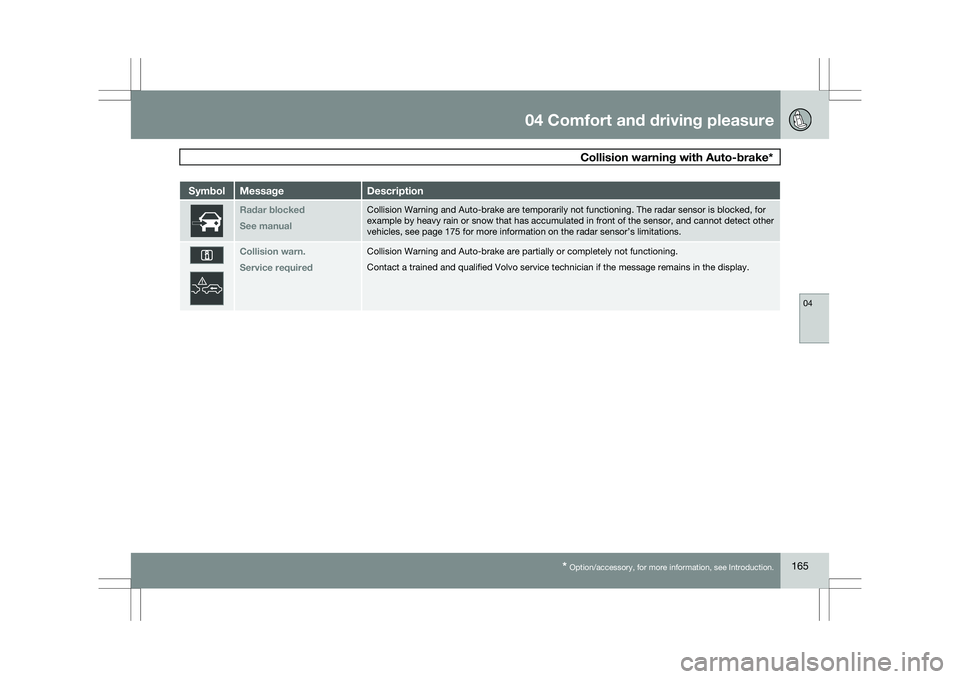
04 Comfort and driving pleasure
Collision warning with Auto-brake*04
* Option/accessory, for more information, see Introduction. 165Symbol Message Description
Radar blocked
See manual Collision Warning and Auto-brake are temporarily not functioning. The ra\
dar sensor is blocked, for
example by heavy rain or snow that has accumulated in front of the senso\
r, and cannot detect other
vehicles, see page 175
for more information on the radar sensor’s limitations. Collision warn.
Service required Collision Warning and Auto-brake are partially or completely not functio\
ning.
Contact a trained and qualified Volvo service technician if the message \
remains in the display.
Page 168 of 297
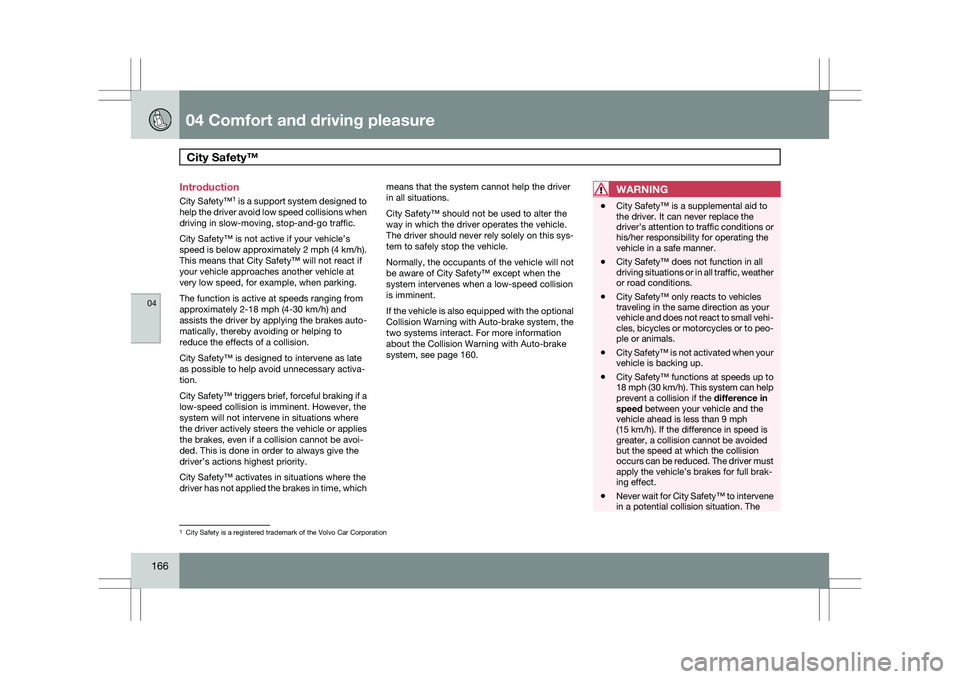
04 Comfort and driving pleasureCity Safety™ 04
166 Introduction
City Safety™
1
is a support system designed to
help the driver avoid low speed collisions when
driving in slow-moving, stop-and-go traffic.
City Safety™ is not active if your vehicle’s
speed is below approximately 2 mph (4 km/h).
This means that City Safety™ will not react if
your vehicle approaches another vehicle at
very low speed, for example, when parking.
The function is active at speeds ranging from
approximately 2-18 mph (4-30 km/h) and
assists the driver by applying the brakes auto-
matically, thereby avoiding or helping to
reduce the effects of a collision.
City Safety™ is designed to intervene as late
as possible to help avoid unnecessary activa-
tion.
City Safety™ triggers brief, forceful braking if a
low-speed collision is imminent. However, the
system will not intervene in situations where
the driver actively steers the vehicle or applies
the brakes, even if a collision cannot be avoi-
ded. This is done in order to always give the
driver’s actions highest priority.
City Safety™ activates in situations where the
driver has not applied the brakes in time, which means that the system cannot help the driver
in all situations.
City Safety™ should not be used to alter the
way in which the driver operates the vehicle.
The driver should never rely solely on this sys-
tem to safely stop the vehicle.
Normally, the occupants of the vehicle will not
be aware of City Safety™ except when the
system intervenes when a low-speed collision
is imminent.
If the vehicle is also equipped with the optional
Collision Warning with Auto-brake system, the
two systems interact. For more information
about the Collision Warning with Auto-brake
system, see page 160.
WARNING \b
City Safety™ is a supplemental aid to
the driver. It can never replace the
driver’s attention to traffic conditions or
his/her responsibility for operating the
vehicle in a safe manner.
\b City Safety™ does not function in all
driving situations or in all traffic, weather
or road conditions.
\b City Safety™ only reacts to vehicles
traveling in the same direction as your
vehicle and does not react to small vehi-
cles, bicycles or motorcycles or to peo-
ple or animals.
\b City Safety™ is not activated when your
vehicle is backing up.
\b City Safety™
functions at speeds up to
18 mph (30 km/h). This system can help
prevent a collision if the difference in
speed between your vehicle and the
vehicle ahead is less than 9 mph
(15 km/h). If the difference in speed is
greater, a collision cannot be avoided
but the speed at which the collision
occurs can be reduced. The driver must
apply the vehicle’s brakes for full brak-
ing effect.
\b Never wait for City Safety™ to intervene
in a potential collision situation. The 1
City Safety is a registered trademark of the Volvo Car Corporation
Page 169 of 297
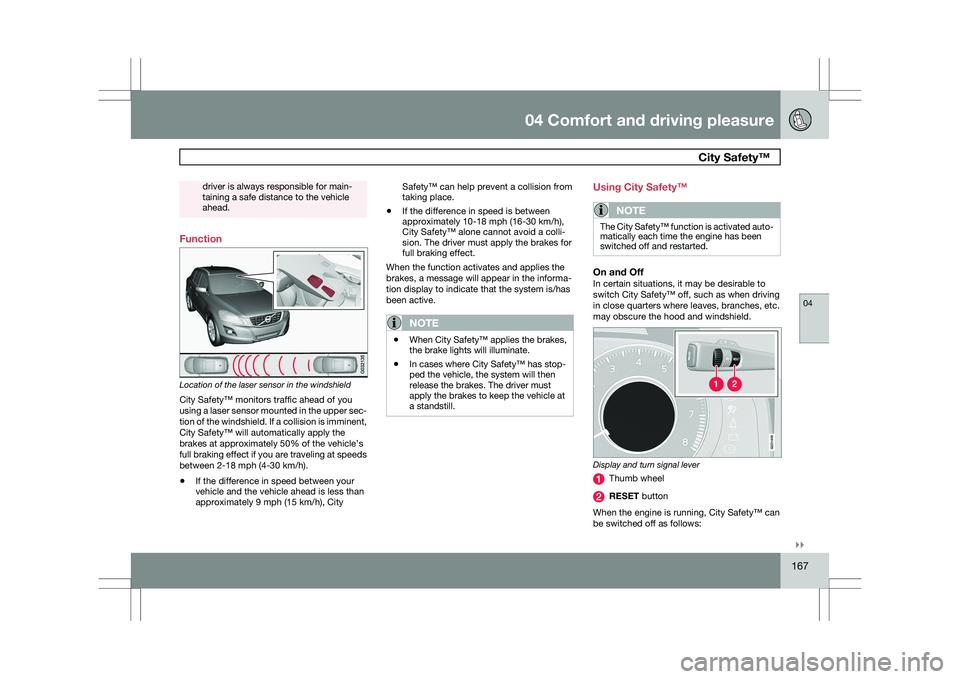
04 Comfort and driving pleasure
City Safety™ 04
}}
167driver is always responsible for main-
taining a safe distance to the vehicle
ahead.
Function
Location of the laser sensor in the windshield
City Safety™ monitors traffic ahead of you
using a laser sensor mounted in the upper sec-
tion of the windshield. If a collision is imminent,
City Safety™ will automatically apply the
brakes at approximately 50% of the vehicle’s
full braking effect if you are traveling at speeds
between 2-18 mph (4-30 km/h).
\b
If the difference in speed between your
vehicle and the vehicle ahead is less than
approximately 9 mph (15 km/h), City Safety™ can help prevent a collision from
taking place.
\b If the difference in speed is between
approximately 10-18 mph (16-30 km/h),
City Safety™ alone cannot avoid a colli-
sion. The driver must apply the brakes for
full braking effect.
When the function activates and applies the
brakes, a message will appear in the informa-
tion display to indicate that the system is/has
been active.
NOTE \b
When City Safety™ applies the brakes,
the brake lights will illuminate.
\b In cases where City Safety™ has stop-
ped the vehicle, the system will then
release the brakes. The driver must
apply the brakes to keep the vehicle at
a standstill. Using City Safety™
NOTE
The City Safety™ function is activated auto-
matically each time the engine has been
switched off and restarted.
On and OffIn certain situations, it may be desirable to
switch City Safety™ off, such as when driving
in close quarters where leaves, branches, etc.
may obscure the hood and windshield.
Display and turn signal lever
Thumb wheel
RESET button
When the engine is running, City Safety™ can
be switched off as follows: G02140
9
Page 170 of 297
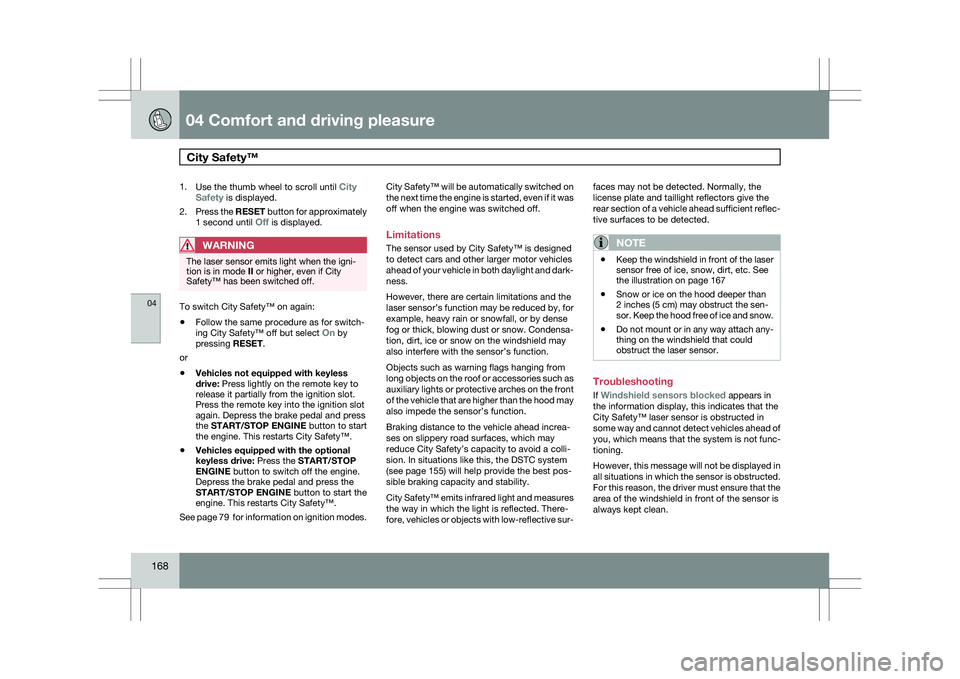
04 Comfort and driving pleasureCity Safety™ 04
168 1.
Use the thumb wheel to scroll until City
Safety is displayed.
2. Press the RESET button for approximately
1 second until Off is displayed.
WARNINGThe laser sensor emits light when the igni-
tion is in mode II or higher, even if City
Safety™ has been switched off.
To switch City Safety™ on again:
\b
Follow the same procedure as for switch-
ing City Safety™ off but select On by
pressing RESET.
or
\b Vehicles not equipped with keyless
drive: Press lightly on the remote key to
release it partially from the ignition slot.
Press the remote key into the ignition slot
again. Depress the brake pedal and press
the START/STOP ENGINE button to start
the engine. This restarts City Safety™
.
\b Vehicles equipped with the optional
keyless drive: Press the START/STOP
ENGINE button to switch off the engine.
Depress the brake pedal and press the
START/STOP ENGINE button to start the
engine. This restarts City Safety™.
See page 79 for information on ignition modes. City Safety™ will be automatically switched on
the next time the engine is started, even if it was
off when the engine was switched off.
Limitations
The sensor used by City Safety™ is designed
to detect cars and other larger motor vehicles
ahead of your vehicle in both daylight and dark-
ness.
However, there are certain limitations and the
laser sensor’s function may be reduced by, for
example, heavy rain or snowfall, or by dense
fog or thick, blowing dust or snow. Condensa-
tion, dirt, ice or snow on the windshield may
also interfere with the sensor’s function.
Objects such as warning flags hanging from
long objects on the roof or accessories such as
auxiliary lights or protective arches on the front
of the vehicle that are higher than the hood may
also impede the sensor’s function.
Braking distance to the vehicle ahead increa-
ses on slippery road surfaces, which may
reduce City Safety’s capacity to avoid a colli-
sion. In situations like this, the DSTC system
(see page 155) will help provide the best pos-
sible braking capacity and stability.
City Safety™ emits infrared light and measures
the way in which the light is reflected. There-
fore, vehicles or objects with low-reflective sur-faces may not be detected. Normally, the
license plate and taillight reflectors give the
rear section of a vehicle ahead sufficient reflec-
tive surfaces to be detected.
NOTE
\b
Keep the windshield in front of the laser
sensor free of ice, snow, dirt, etc. See
the illustration on page
167
\b Snow or ice on the hood deeper than
2 inches (5 cm) may obstruct the sen-
sor. Keep the hood free of ice and snow.
\b Do not mount or in any way attach any-
thing on the windshield that could
obstruct the laser sensor. Troubleshooting
If Windshield sensors blocked appears in
the information display, this indicates that the
City Safety™ laser sensor is obstructed in
some way and cannot detect vehicles ahead of
you, which means that the system is not func-
tioning.
However, this message will not be displayed in
all situations in which the sensor is obstructed.
For this reason, the driver must ensure that the
area of the windshield in front of the sensor is
always kept clean.